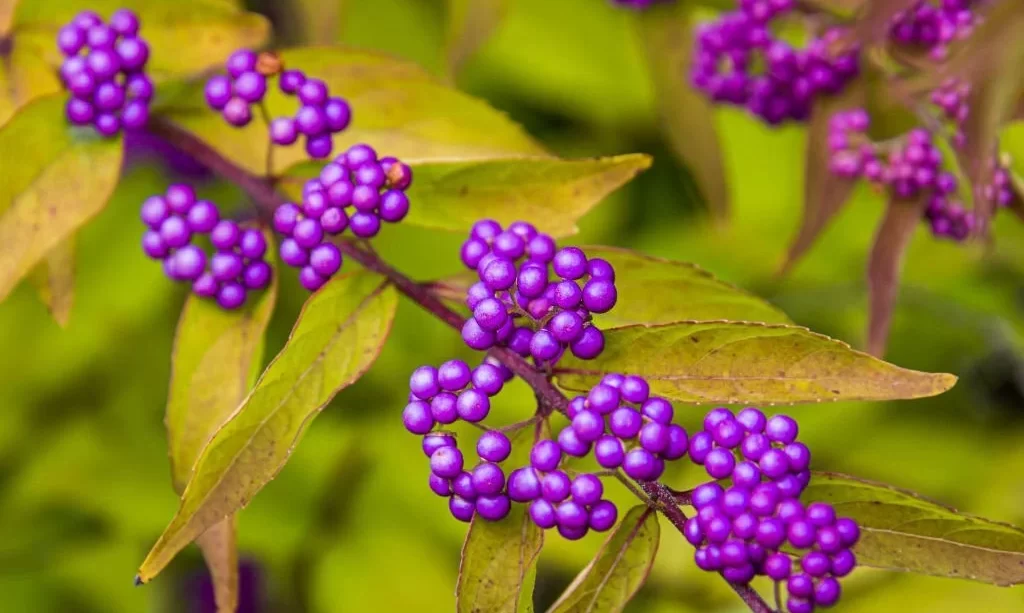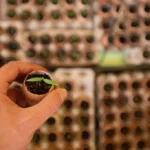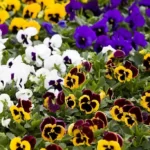Beautyberries, with their vibrant clusters of purple, pink, or white berries, are a sight to behold in gardens and natural landscapes. These colorful jewels, adorning the branches of beautyberry plants, add a touch of wonder to the world of flora. Yet, beyond their ornamental allure, questions often arise about whether these striking berries are not only visually captivating but also edible. In this article, we embark on a journey to uncover the truth about beautyberries. Are they safe for consumption, or should they be admired solely for their aesthetics? To start our exploration, let’s delve into what makes beautyberries unique and why they have captured the attention of gardeners and nature enthusiasts alike.
- It is fully rooted in the soil and can be planted immediately upon arrival, weather permitting. Planting and how-to-care instructions will arrive with shipment.
- For best results, plant in USDA Zones 5-8. Mature height is 5-6ft, mature spread is 6-7ft.
- New foliage emerges bronze in Spring, maturing to a deep green by summer. Small, soft pink flowers bloom in June.
- Small berries that start green and change to an electric purple arrive in August. Grows well in full or partial sun.
- Plant will be dormant (no leaves) late Fall through the Winter months, this is normal. It will leaf out in Spring.
Beautyberries
Beautyberries, scientifically known as Callicarpa, are a genus of flowering plants that have captivated the hearts of those who appreciate the wonders of the natural world. These plants are recognized for their distinctive clusters of berries, which appear in various shades, depending on the species and variety. The most common and eye-catching are the vivid purple beautyberries, but some species also produce pink or white berries.
What sets beautyberries apart is their remarkable appearance and their role as ornamental plants. The berries, often arranged in showy clusters along the stems, serve as a striking focal point in gardens and wild landscapes. As such, beautyberries are cultivated for their aesthetic value and ability to add a pop of color to outdoor spaces.
While the ornamental appeal of beautyberries is undeniable, it raises the intriguing question of whether these visually stunning berries are more than just a feast for the eyes. Can they be safely consumed, and do they hold any culinary potential? To begin our journey into the world of beautyberries, let’s first uncover their unique characteristics and the botanical wonders that make them a beloved presence in both gardens and the wild.
The Edibility of Beautyberries
The question of whether beautyberries are edible is a common one among those intrigued by these alluring berries. Beautyberries, in general, are not typically considered toxic to humans, but their edibility comes with some important considerations.
While they are not widely consumed as a food source, beautyberries are not generally considered poisonous. However, their safety and palatability can vary depending on the species and variety. Some species, like Callicarpa americana, are known to have a milder flavor and are more suitable for culinary use, while others may have a less desirable taste.
The primary culinary use of beautyberries involves processing them into jams, jellies, sauces, or desserts. Their bright color and natural pectin content make them a potential ingredient in creating unique and visually appealing preserves.
It’s essential to note that the taste of beautyberries can be quite distinctive, with a slightly astringent or medicinal undertone. As a result, beautyberries are often used in combination with other fruits and sweeteners to balance their flavor.
- 🌿 Vibrant Display: Showcases stunning purple berries in clusters, ensuring your garden is the talk of the town.
- 🌸 Wildlife Magnet: Invites a flurry of birds and butterflies, enhancing the liveliness of your yard.
- 🍂 Drought Resilient: Stands strong in various conditions, ideal for eco-friendly and low-water gardens.
- 🍁 North American Native: A proud specimen of the US flora, blending seamlessly with regional environments.
- 🌼 Easy Growth: Adaptable to diverse soils and demands little attention, perfect for gardeners of all expertise levels.
Varieties of Beautyberries
Beautyberries belong to the Callicarpa genus, which includes several species and varieties. Understanding the different types of beautyberries is essential for those interested in exploring their edibility and culinary potential.
One of the most well-known species is Callicarpa americana, often referred to as American beautyberry. This species is frequently praised for its milder flavor and suitability for culinary use. Its berries are more likely to be used in jams, jellies, or desserts.
In addition to Callicarpa americana, there are other species and varieties of beautyberries, such as Callicarpa japonica, Callicarpa dichotoma, and Callicarpa bodinieri, each with its unique characteristics. While some may have a more pronounced flavor or astringency, others may be better suited for ornamental purposes.
When considering the edibility of beautyberries, it’s advisable to research and identify the specific species or variety you encounter, as taste and culinary applications can vary. Some may find that the milder-flavored varieties offer a delightful addition to their culinary creations, while others may prefer to appreciate beautyberries solely for their visual charm in gardens and landscapes.
- Due to California Department of Agriculture we CAN NOT ship this item to the state of California***
- Zone 6 -10
- Grows in a long, arching branches that droop downward and produces tight little clusters of glossy, iridescent, purple fruit. Attracts birds, bees and butterflies.
- Full sun to partial sun
- This American Beautyberry comes in a 1 Gallon pot
Culinary Uses of Beautyberries
While beautyberries are not commonly regarded as a staple food, they do offer unique culinary possibilities for those who appreciate their distinctive flavor and striking appearance. Here are some ways in which beautyberries can be used in the kitchen:
- Jams and Jellies: One of the most popular culinary applications of beautyberries is in the creation of jams and jellies. Their natural pectin content helps set these preserves, and their vibrant color adds visual appeal to homemade spreads.
- Sauces and Condiments: Beautyberries can be used to prepare tangy sauces and condiments, often combined with other ingredients like sugar, vinegar, and spices. These sauces can be drizzled over meats, used as glazes, or served alongside various dishes.
- Desserts: Beautyberries can add a unique twist to desserts, such as pies, cobblers, and tarts. Their slightly tart and sweet flavor can complement other fruits and ingredients, creating delightful and visually stunning treats.
- Beverages: Beautyberries can be infused into beverages, including cocktails and mocktails, to impart their distinctive flavor and vibrant hue. They can also be used to make beautyberry tea by steeping the dried berries.
- Decorative Garnish: Beyond their culinary uses, beautyberries can be employed as decorative garnishes for dishes, desserts, and beverages, adding a pop of color and an element of surprise to presentations.
Precautions and Considerations
While beautyberries are generally considered safe for consumption, some precautions and considerations should be kept in mind:
- Proper Identification: Ensure that you correctly identify beautyberries before using them in culinary endeavors. While many species are non-toxic, it’s crucial to avoid any potentially harmful look-alike berries.
- Allergies and Sensitivities: Individuals with allergies or sensitivities should exercise caution when trying beautyberry-based recipes. As with any new food, it’s wise to consume a small amount initially to gauge any adverse reactions.
- Taste Preferences: Keep in mind that the taste of beautyberries can be slightly astringent or tart, and it may not appeal to everyone’s palate. Experimenting with recipes and flavor combinations can help balance their unique flavor profile.
- Variety Matters: The specific species or variety of beautyberries you encounter can impact taste and culinary applications. Some varieties may be more suitable for certain dishes than others.
Conclusion
In conclusion, beautyberries, with their vibrant clusters of berries, offer a delightful opportunity to explore unique culinary creations and decorative presentations. While they are not a common food source, their distinct flavor and color can enhance a variety of dishes, from preserves to desserts and sauces.
When considering the edibility of beautyberries, it’s important to exercise proper caution, including correct identification and consideration of individual allergies or sensitivities. Additionally, the specific species or variety of beautyberries you encounter can influence their taste and culinary applications.
Whether you choose to incorporate beautyberries into your culinary repertoire or simply appreciate them for their ornamental value, these captivating berries continue to inspire curiosity and creativity in the realms of gardening and gastronomy.






